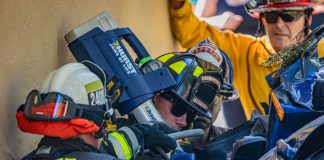
Twenty-five years have now passed since the 1989 Loma Prieta earthquake — a 6.9-magnitude temblor — rocked the San Francisco and Monterey bay areas, causing millions of dollars in damages throughout the region.
Over the course of that quarter-century, the physical scars of that devastating event have largely faded from view. However, the memories of what happened at 5:04 p.m. on Tuesday, Oct. 17, 1989 — and the days that followed — still reverberate today.
While property damage and fatalities in Oakland and San Francisco dominated most national headlines — including Game 3 of the 1989 World Series between the San Francisco Giants and the Oakland Athletics — the epicenter of the quake was in Nisene Marks in Santa Cruz County, ensuring that the entire region was among those hardest hit.
Although Watsonville and Downtown Santa Cruz both famously sustained horrific damage, the rural communities of Scotts Valley and the San Lorenzo Valley were no less severely affected.
For many residents, life would never be quite the same again.
Businesses, bridges, roadways, homes, and infrastructure — none of it was immune to the Earth’s shaking.
Many families found themselves suddenly unable to return to their homes after the quake destroyed more than 100 homes. Hundreds more homes sustained major structural damage and were eventually demolished after inspections deemed them unsafe.
Any house with masonry or a brickwork chimney was almost guaranteed to have sustained damage.
“It was a mad dash to get home and see what kind of damage (had happened),” recalled Linda Lovelace, operations director for Valley Churches United Missions. “You didn’t even think about all of the little bridges you have to cross.”
Lovelace said she was having work done on her van in Scotts Valley when the quake struck.
“I’m sitting in the van and it starts to rock,” she said. “We looked at Scotts Valley Drive, and the road went like a ribbon.”
Power grids and phone lines were damaged across the region, and many areas were without power or phones for the better part of a week — some for much longer.
For nearly a week, amateur operators using high-frequency radio broadcasts served as the only means of communication between Santa Cruz County and Sacramento.
Roadways and bridges were damaged, some irreparably so. Meanwhile, Highway 17 was made impassable by the shifting ground, leaving Highway 9 as one of the few remaining ways in and out of the county.
With most supply routes into Santa Cruz County cut off, and most power and communication lines severed, residents found they could not buy food, fuel, or much of anything else for many days.
Lines soon formed outside local grocery stores as people stood for hours waiting to get jugs of water, flashlights, batteries, and other essential items.
As the dust settled and the aftershocks subsided, the communities — accustomed to natural disasters in the wake of the severe winter storms in the early 1980s — rallied to the aid of their neighbors to begin picking up the pieces.
“It was quite a remarkable and heartfelt recovery,” said 5th District Supervisor Bruce McPherson, who had found himself alongside his son at old Candlestick Park waiting to see Game 3 of the World Series when the quake struck. “It was time of disaster, but also a time of community and healing.”
As relief supplies and donations began to trickle into the community, local organizations such as Valley Churches United Missions, spearheaded efforts to distribute them to those in need.
According to VCUM documents, the organization’s North County Outreach Center distributed nearly $600,000 worth of contributions to nearly a thousand local families, including food vouchers, funds for home repairs, money for mortgage and relocation assistance, as well as furniture, pet food, and personal items.
As was so often the case when disaster struck, the late Annette Marcum — VCUM founder and director — was at the forefront of the relief efforts.
Marcum, who was in Wisconsin with her daughter when the quake struck, recalled hearing about it on the news — and not being able to reach anyone on the phone.
“I have never felt so helpless in my life as we waited to receive word of our loved ones’ fate,” Marcum said in the written account she kept of the quake and its aftermath.
By the time she was able to get back to California two days later, she returned to find her home community looking like a war zone — and the organization she’d founded already hard at work.
“I arrived Thursday morning to find the loyal, dedicated volunteers of the Valley Churches United hard at work, with Board Chair Susan Mihalik in charge” her journal reads, “already distributing food from our emergency food pantry and accepting donations which had started to come in.”
As donations began to stream in — more than the organization’s food pantry could hold, Marcum said, the facilities of the nearby Park Hall and St. Andrew’s Episcopal Church were pressed into service as food and supply storage and distribution centers.
One of the volunteers to come to Valley Churches United in the wake of the quake was Linda Lovelace, who would go on to become one of the organization’s key members, a role she still serves today.
“That was when I became involved,” she said. “I went down to volunteer after the earthquake and I never left.”












